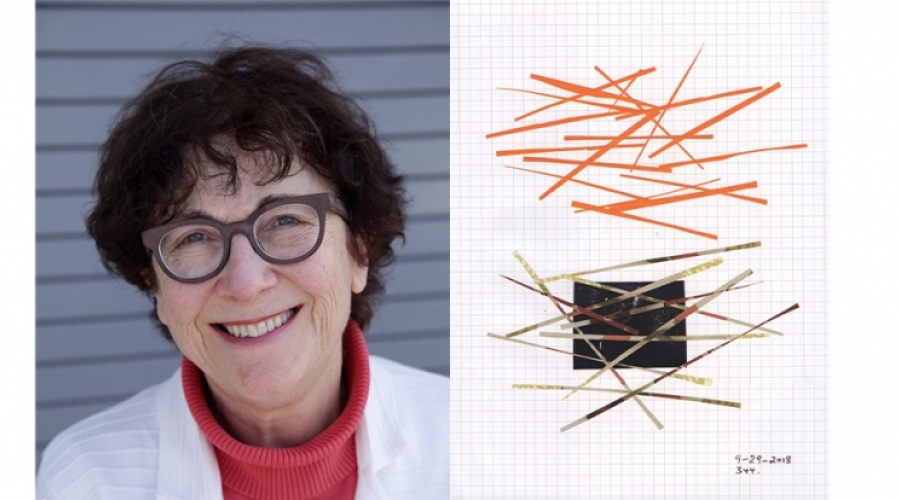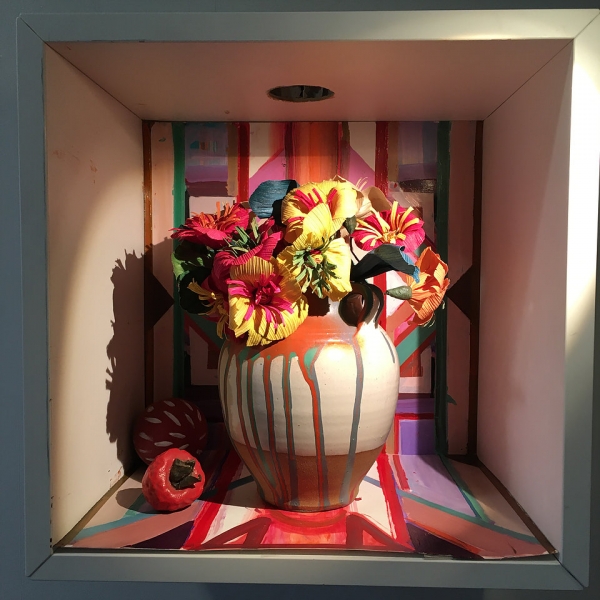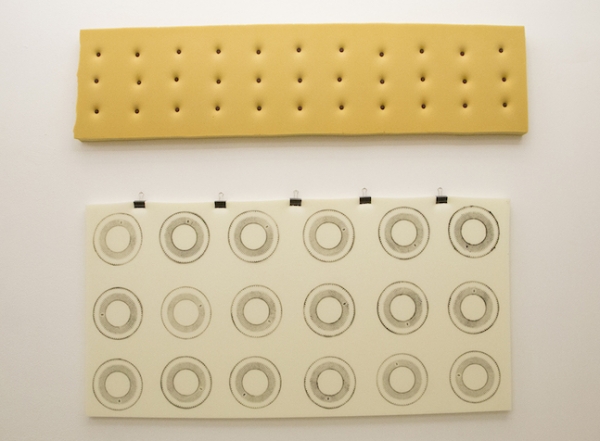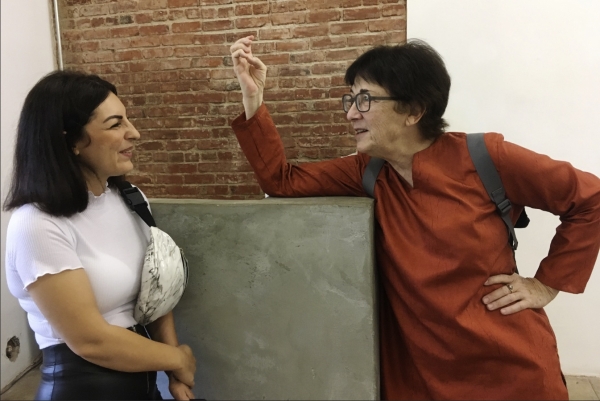
 Outside the office of Annetta Kapon (BFA ’85) at the Otis College of Art and Design Graduate Studios in Culver City is a small gallery, operated and curated by the interim chair of the MFA Fine Arts program herself. To the untrained eye, Proxy Gallery might look like a box mounted to the wall, which, of course, it is—one cubic foot—but Kapon, as well as students, artists, and critics, view it as an intervention on the discourse of art production and reception, where the work of known, unknown, and very well-known artists can be seen. “The gallery has also established itself as a critical engagement with the bifurcation between the artist and the ‘system’ of exhibition-distribution-consumption,” Kapon says. “The Proxy Gallery needs that institutional seriousness because it makes use of those categorical boundaries, which are the very subject of its existence. That’s why it is officially called a ‘gallery’ and not a project, space, experiment, corner, box, and so on. My motto is that humor takes a lot of seriousness. Humor is not funny. Proxy has humor, but it’s not a joke.”
Outside the office of Annetta Kapon (BFA ’85) at the Otis College of Art and Design Graduate Studios in Culver City is a small gallery, operated and curated by the interim chair of the MFA Fine Arts program herself. To the untrained eye, Proxy Gallery might look like a box mounted to the wall, which, of course, it is—one cubic foot—but Kapon, as well as students, artists, and critics, view it as an intervention on the discourse of art production and reception, where the work of known, unknown, and very well-known artists can be seen. “The gallery has also established itself as a critical engagement with the bifurcation between the artist and the ‘system’ of exhibition-distribution-consumption,” Kapon says. “The Proxy Gallery needs that institutional seriousness because it makes use of those categorical boundaries, which are the very subject of its existence. That’s why it is officially called a ‘gallery’ and not a project, space, experiment, corner, box, and so on. My motto is that humor takes a lot of seriousness. Humor is not funny. Proxy has humor, but it’s not a joke.”
Kapon has hosted 70 exhibitions at Proxy Gallery in the last seven years, including a recent show by L.A. painter Karen Carson. “The model of gallery representation is only one model out of many. In my expanded view of success, many other discourses are included, specific practices, other ways for people to show their work or be engaged discursively,” says Kapon, who’s been teaching at Otis College since 1992. “Proxy Gallery was a way to take things into my own hands and address the whole issue of the kind of supplicant position of the artist versus the gallery, the ‘please give me a show’ thing.”
 Kapon, herself a multimedia artist who received her BFA from Otis College and her MFA from UCLA (in addition to the BA and MA degrees in English she already held), has had her work shown in museums and galleries all over the world. But her practice is rooted in experimental and exploratory ideas, much like the program she currently chairs at Otis, after being an assistant chair for the last 17 years. For starters, it’s interdisciplinary—there is no separate painting or sculpture or photography department. Everyone in the MFA Fine Arts program is an artist—a reflection, according to Kapon, of the current state of the art world. “[Students] can be medium-specific, or not,” she says. “One artist might work in ceramics, another person might make paintings, others do not have a specific material or a method, but there is always an idea or intention that traverses the work. The advantage is that they don’t have to declare a specific genre, and they meet other artists having diverse approaches and practices.”
Kapon, herself a multimedia artist who received her BFA from Otis College and her MFA from UCLA (in addition to the BA and MA degrees in English she already held), has had her work shown in museums and galleries all over the world. But her practice is rooted in experimental and exploratory ideas, much like the program she currently chairs at Otis, after being an assistant chair for the last 17 years. For starters, it’s interdisciplinary—there is no separate painting or sculpture or photography department. Everyone in the MFA Fine Arts program is an artist—a reflection, according to Kapon, of the current state of the art world. “[Students] can be medium-specific, or not,” she says. “One artist might work in ceramics, another person might make paintings, others do not have a specific material or a method, but there is always an idea or intention that traverses the work. The advantage is that they don’t have to declare a specific genre, and they meet other artists having diverse approaches and practices.”
 For the 25 to 35 students in the two-year graduate program at any one time, it’s an environment rich with inspiration that fosters a tight-knit, artistically diverse community. It’s the discourse that provides unification—critique is “the heart of the program,” Kapon says. “We look at the work from many points of view: Its materiality [but also], what is it doing, how is it doing it, what does it want to communicate, what does it communicate? That helps the artists understand the difference between their intentions and what the audience is seeing.” A student’s work is critiqued twice a semester, for three hours at a time, but “everybody learns from other people’s critiques.”
For the 25 to 35 students in the two-year graduate program at any one time, it’s an environment rich with inspiration that fosters a tight-knit, artistically diverse community. It’s the discourse that provides unification—critique is “the heart of the program,” Kapon says. “We look at the work from many points of view: Its materiality [but also], what is it doing, how is it doing it, what does it want to communicate, what does it communicate? That helps the artists understand the difference between their intentions and what the audience is seeing.” A student’s work is critiqued twice a semester, for three hours at a time, but “everybody learns from other people’s critiques.”
It’s not only the program that is interdisciplinary. “Our dedicated faculty come from different practices themselves,” Kapon says. “Some are working in photography, video, painting, or sculpture, social practice or writing, but we don’t see students according to our own specialty. I may make video, but I talk to people who are painters or photographers, etc. So, the students have access to faculty from different aspects of art practice.” Access is another critical element of the MFA Fine Arts program: With eight to nine faculty members, the student-to-professor ratio is incredibly small, and that accessibility is compounded by faculty members’ commitment to availability. “If you don’t like talking you shouldn’t come here,” Kapon jokes dryly, “because everybody talks to everybody. It’s very discussion-oriented.”
Kapon is best known for her sculptures and installations, but in April of last year, several of her collages were hung in Santa Monica’s Arena 1 Gallery as part of its “Every Ongoing Day” exhibition. Her collages are relatively simple, 2-D and abstract, done on notebook graph paper. Each one is marked with a day, month, and year, and those on display were just a sliver of the many hundreds Kapon has created, one a day, since 2017. It’s a practice she implemented for much the same reason that she started Proxy Gallery—to keep her relationship to creation, engagement, and experimentation fresh—to expand her art. It’s this kind of drive she hopes the MFA Fine Arts program will foster for every student.
“The biggest thing I want for [students], both during the program and after, is engagement. Be engaged with the program, put your heart into it,” Kapon says. “And the other thing is persistence, persistence to sustain your practice. I’m in touch with a lot of alumni. Some have gone on to do a PhD in another field and have become professionals in other things. Some have opened galleries of their own. Many are teaching. Some are collectors, some are directors on boards. Many, of course, are showing in galleries and museums. All of that I consider successful. It’s continuing a kind of practice. Whatever you’re doing, don’t stop doing it.”
Applications for the MFA Fine Arts program at Otis College of Art and Design currently are being accepted, with a Priority Deadline of January 15, 2020. For more information about the MFA Fine Arts program, please click here. For more information about Kapon, please click here.
Portrait of Kapon by Janet E. Dandridge. Photo of Kapon with Shirin Bolourchi (MFA Fine Arts, ’17) by Antonis Ricos. All other work provided by Kapon and Proxy Gallery.


